
Luxury boutique hotel Alila comes to China, located in the bamboo forests of Anji
Imperial Tours has compiled another roundup of what’s happening and what’s new in China luxury travel this spring.
Art, Culture & Fashion
This month will unveil the opening of the first Shanghai store for home-grown fashion designer Ms Min. Up until now her gorgeous designs were only available online or in department stores like Lane Crawford. The new store is designed by Italian architect Vincenzo de Cottis and is housed in the Shanghai Centre.
Hong Kong’s Art Basel has now been and gone but there’s still plenty to see art wise in Hong Kong. One of Asia’s hottest artists, Shahzia Sikander from Pakistan, has her first solo show at the Asia Society Hong Kong Centre until early July. Meanwhile Galerie du Monde is exhibiting 25 works from The Fifth Moon group of Taiwanese artists, running from April 20 to June 01.
Running until May 28 at Pekin Fine Arts in Beijing’s Caochangdi is an exhibition by Hong Kong’s late Wesley Tongson. His modern take on Chinese ink landscape paintings are both beautiful and haunting.
Ms Min's designs are stylish and chic
Dining
There’s less news from the fine dining scene with only a few new places opening recently. If you’re in Shanghai and looking for a taste of something different then head to Alan Wong’s Shanghai at the Ritz Carlton. Alan is a celebrity chef from the US who specializes in Hawaiian regional cuisine, so if you love fish then you should definitely consider stopping by for a meal.
In Beijing The Georg is a wonderful new fine dining spot that actually opened quietly late last year. The restaurant is part of the Danish silverware and lifestyle brand by Georg Jensen and the food is a ‘Scandinavian take on international flavor driven cuisine’.
A touch of Danish class in Beijing at The Georg by Georg Jensen
Hotels
The St. Regis Macao opened just before the New Year on 17 December. They are the first property in Macao to offer a signature 24-hour Butler Service for every room and suite. In February the Grand Hyatt opened its doors in Chengdu, located in the same fashionable district as Swire’s Temple House.
Currently in soft opening phase is Ahn Luh Zhujiajiao, the first in a new chain of luxury hotels set to open in second-tier cities in China by the founder of Aman. It’s billed as an urban resort and is located in the water town of Zhujiajiao near Shanghai. We presume this chain will be aimed at the domestic market what with their spa being run by a Tai Chi expert and a focus on TCM (Traditional Chinese Medicine).
Recently opened St. Regis in Macao
Although this is now slated for a fall opening we are nonetheless already excited about the opening of the first Alila luxury boutique hotel in China. The setting will no doubt be stunning as the hotel will be situated next to a lake in the peaceful bamboo forests of Anji in Zhejiang province, where Crouching Tiger, Hidden Dragon was filmed (see top photo).
Finally, we are still waiting in anticipation for the opening of the Waldorf Astoria in Chengdu. The property was originally slated to open in 2016 but seems now to have been moved back to 2017. Likewise, no news yet on the opening date of the Four Seasons Tianjin which is due to open sometime this year.
We look forward to seeing what else is in store on the luxury scene in China through the year. In the meantime, check out our luxury China travel collection of photos here or to keep up with all the information on luxury happenings in China please like our Facebook page.

China has been a land fueling creativity for thousands of years but there seems to have been a resurgence of interest from the West in Chinese creativity recently. Last year, the Metropolitan Museum of Art in New York and a handful of other museums featured exhibits on Chinese art. In the previous year, The Smithsonian showcased Chinese-American food and this past November The Met documented Chinese fashion and its global impact. Both exhibits noted that Chinese culture has been influencing the West for centuries.
As vast as its realm of influence, China offers many ways to explore its impactful fashion and food scenes at their origins and there’s never been a better time to do so. Below, we’ve listed a few events in order to help you choose from your myriad of options. From fashion weeks to cooking lessons, China will leave you with worlds of knowledge.
Hong Kong Fashion Week
As Asia’s largest Fashion Fair, Hong Kong Fashion Week for Fall/Winter collections features a variety of themes ranging from Emporium de Mode to Cashmere & Wool and offers inspiration as well as a view into current global fashion trends. January 18-21
Beijing Mercedes-Benz China Fashion Week
Mercedes-Benz China Fashion Week offers fashions shows and competitions featuring works from 450 designers. This event combines fashion design, accessories, styling and new technologies which show off China’s new breed of designers. March 25-31
Shanghai Park Hyatt’s Masters of Food and Wine
The Park Hyatt’s Masters of Food and Wine events are held at numerous Park Hyatts around the world. They offer personal time and attention with international as well as locally sourced award-winning chefs, farmers, sommeliers, and craft brew masters in intimate settings. The Shanghai Park Hyatt’s event, now called Passion Week, offers in-depth insight from the best in culinary arts and entertaining. Here, “masters” of the trades form a connection between you and China through food, their passion and some edible influence. Exact dates are not yet announced but this event usually takes place over Thanksgiving week. Fall 2016
Design a trip with Imperial Tours to incorporate one of these events in order to have a premier experience while you see and taste for yourself how and why China continues to influence the world with its food and its style.

Masters of Food and Wine 2011 – 2014
This November take a personal side trip for passion. Park Hyatt Beijing and Park Hyatt Shanghai are once again hosting the annual “Masters of Food & Wine” series and both tables are set to take guests into the creative minds of world-renowned chefs, sommeliers and artists.
The event in Beijing called “Soul Mates” takes place on November 14 and features Executive Chef Jack Aw Yong and well-known food critic Craig Au Yeung. Together they will explore simple and fresh ingredients, and how simplicity can tie everything together. Accompanying them in their journey to turn “roots” into fine gastronomy will be Advanced Sommelier Meiyu Lee.
November 24 to November 27 marks “Passion Week” for Park Hyatt Shanghai. Guests can experience gala dinners guided by Michelin-starred Chefs and participate in wine tastings and classes taught by world class sommeliers. This year the master chefs participating will be Pierre Gagnaire, Emmanuel Renaut, Akrame Benallal as well as S. Pellegrino 50 Best Restaurants and Asia’s Best Female Chef 2014, Lanshu Chen. Other classes such as in fine jewelry making and floral arrangement are also offered. This showcase will give connoisseurs and beginners alike a behind-the-scenes look at the masters of modern food, wine, art and crafts.
Highlights from these events include:
– Four gala dinners featuring meals from three Michelin-starred French chefs
– Four master wine classes/tastings conducted by four wine experts
– PÂTISSERIE master class
– Floral design class
– Watchmaking master class from Jaeger-leCoultre
– Jewelry making class
– Photography exhibition
If fine wine and first-rate food are up your alley, contact us and we’ll help you put together a customized luxury China trip, chock-full of food and wine, and by incorporating one, or better yet both, of the Park Hyatt Masters of Food and Wine events.

Minsheng Art Museum in Beijing
Imperial Tours has compiled another roundup of what’s happening and what’s new in China luxury travel this fall.
Art & Culture
Fall is a busy time on the art scenes in China’s key cities. Beijing Design Week (Sep. 23rd to Oct. 7th) is running for a total of two weeks this year and they have expanded their number of installations and events across the city. Shanghai is hosting both the Shanghai Art Fair in November and the Art 021 Shanghai Contemporary Art Fair – both key events for buyers of contemporary art.
A new gallery has recently opened in Beijing up in the 798 art space in a converted electronics factory. Minsheng Art Museum is architecturally stunning but as it’s only recently opened the exhibitions are rather bare so we recommend going for the architecture rather than the art at this stage.
Visitors to Shanghai can now reflect on an interesting part of its global history whilst sipping coffee at the historic White Horse Café which recently re-opened in Shanghai’s Jewish quarter. The cafe was first opened in 1939 and quickly became a hub for Jewish refugees fleeing Nazi persecution. Shanghai has recently applied for the Jewish quarter to be recognized in the UNESCO Memory of the World register.
Award-winning interior of Mott 32 in Hong Kong
Dining
Beijing’s luxury fine dining establishment Temple Restaurant (TRB) has just opened a casual dining restaurant TRB Bites. We visited for dinner during their soft opening and can tell you it’s just as wonderful as you’d expect from the TRB team. It’s taken over the space that was The Courtyard by Brian McKenna, and for those not in the know that means a space overlooking the moat of the Forbidden City at its east gate – definitely a place to wow visitors to Beijing. You can choose from 3 to 5 courses from the menu and the quality and presentation of the food are almost on a par with TRB. Where it becomes more casual is that it sports an open kitchen and tables are much closer together meaning it feels less exclusive than TRB.
Speaking of Brian McKenna, he has also decided to go down the more casual eatery route with his new venue Molly Malone’s Gastropub and Grill at the Legendale hotel in Wangfujing. We haven’t tried it yet but expect British pub food with a gourmet, celebrity chef touch!
In Hong Kong Mott 32 has been serving up fine Chinese food for just over a year now but is definitely still worth a mention here. Our staff recently stopped by for dinner and were very impressed by both the food and the interior style. If it’s excellent dim sum you’re looking for then this restaurant delivers as all their dim sum is prepared on-site, unlike many other restaurants. The décor and design are very fitting given that it’s a contemporary Chinese restaurant beneath one of Hong Kong’s oldest banks. In fact, the restaurant was named World Interior of the Year in 2014 so it’s not only Imperial Tours that are impressed!
de Gournay wallpaper at the Beijing showroom
Luxury Hotels
One of the most talked about hotel openings in recent months has been The Temple House hotel in Chengdu, the third addition to the ‘House’ group of hotels by Swire. Chengdu is one of the fastest growing destinations for tourists in China and now ultra-luxury travelers are catered for with this chic new property. You can read our full review here.
In Beijing the NUO hotel has recently opened in the 798 art district. It’s the first of a Chinese chain of luxury hotels which has plans to go global. We have already tried and tested their restaurant which is excellent and makes a nice break from touring the many art galleries in the area.
Shopping & Fashion
de Gournay, famous for their exquisite hand painted wallpaper, have recently opened a showroom in Beijing. Located in a beautiful Chinese courtyard in the hutongs it’s their second store in China after Shanghai. If you are looking for something unique to take home then de Gournay’s Emperor Collection is currently on sale only in China, before a later worldwide release.
Top designers’ spring and summer collections will be on show for China Fashion Week in Beijing in late October. China Fashion Week is now well-established with sponsorship from Mercedes-Benz and is held twice a year to showcase all the in seasonal collections.
Finally in other news Imperial Tours has recently started an Instagram account so you can now get China travel inspiration on your phone as you go. Check out our luxury China travel collection of photos here or to keep up with all the information on luxury happenings in China then like our Facebook page.
Dim sum – typical Cantonese regional cuisine
1. Diversity: There are 8, some argue 9, distinct regional cuisines in China. These have been grouped into 4 schools of cooking, each with very distinct flavors, use of ingredients and style of cooking. They can be categorized in the following way: North – this is the cuisine of Beijing, Inner Mongolia and imperial Shandong which features heavy use of leeks and onions and includes stewing and roasting techniques (think Peking roast duck). West – This is where the spiciest food of China originates (Sichuan), with the stir-fry cooking favoring the use of chilies, garlic and ginger. East – More use of steaming and lighter flavors with soy sauce and rice wine. South – Cantonese is the best-known outside of China including sweet and sour flavoring and lightly flavored dim sum. As China is such a huge country and the cuisine from each region so varied it would take months if not years to try all the different dishes China has to offer. Aim to try a few dishes from each school to understand the different flavors and techniques used, and to find which regional cuisines suit your taste buds.
2. Vegetables: One of the surprising things about Chinese food in China is just how many types of vegetables you see served. Lots of the cuisine here is extremely healthy and actually far less oily than in Chinese restaurants overseas. You get a lot of cold salads on the menus such as pai huang gua – 拍黄瓜 (smashed cucumber with garlic) and liangban mu er – 凉拌木耳 (wood ear mushrooms with raw onion and chili). There are many vegetables in China that you are unlikely to have seen before but which you should most certainly try. Ones to look out for are bitter melon (ku gua – 苦瓜 – as bitter as it sounds), winter melon (dong gua – 冬瓜), dragon beans (long dou – 龙豆) and celtuce (wo sun – 莴笋). Yunnan food especially uses very interesting and unique ingredients such as a wonderful dish using jasmine flowers fried with eggs. But even simple dishes such as broccoli fried with garlic taste wonderful in China – juicy and crunchy and much tastier than how it is typically cooked in the west. Eggplant is also especially creamy and tasty in Chinese dishes so worth looking out for.
Spicy Chongqing la zi ji
3. Street Food: Although not as famous as that of southeast Asia, street food in China is still good. If you love street food then you should definitely visit Xi’an. Head to the Muslim Quarter near the Great Mosque and feast on lamb skewers sprinkled with cumin (yangrou chuan – 羊肉串); Uighur flat breads (kao nang – 烤馕); roujiamo – 肉夹馍 (a kind of sandwich filled with pork and cilantro); and bowls of thick, steaming noodles (try daoshaomian – 刀削面 and biangbiang mian – the character for biang is so complicated that it cannot even be typed on a computer!). Hong Kong also has great street food but you are best off braving the queues and going during lunch time on a weekday when all the office workers ensure things are kept fresh.
4. Spice: If you like spicy food forget India, China is where things really hot up! Sichuan and Hunan cuisine are the spiciest by a long way. Sichuan even has its very own spice – Sichuan pepper (hua jiao – 花椒) which has a numbing but buzzing effect on the mouth, it’s quite unique and certainly a must try! Chengdu is the mecca for spicy food in China, although you can find decent Sichuan restaurants throughout the country. The very fiery dishes are Chongqing la zi ji – 重庆辣子鸡 which is chicken fried with no small amount of chili; shao chao rou – 少炒肉 which is sliced pork fried with scallions and chili; mala xiangguo – 麻辣香锅 – a pot of vegetables and meat mixed together with chili and Sichuan peppercorns; and hotpot (huoguo – 火锅). The best hotpot places are the ones where you can choose the level of spice – spice fiends should go for ‘te la’ – 特辣 (very spicy) and if you like your spice but can’t quite handle a vindaloo then go for ‘wei la’ – 微辣 which is still very spicy – you have been warned!
Despite China being a nation obsessed with food, there are a surprising number of mediocre restaurants around so you should try and do your research on where to go before heading for dinner. If you come to China with Imperial Tours then let our China Host or virtual concierge know that you want to try particular types of Chinese food so that they can make restaurant recommendations based on this. You will also receive a list of restaurants with our personal recommendations from each menu. If you travel with a China Host then this adds an additional level of service for the foodie traveler because the Host is constantly refining the restaurants you visit and re-tuning the menus based on your tastes. Foodies may be interested in attending Hong Kong’s annual Wine & Dine Month in October and Shanghai Park Hyatt’s Food & Wine Festival in November – we can customize tours around these events We can also arrange cooking classes for those who want to hone their culinary skills in a Chinese kitchen. You can start to plan your itinerary here.
For further foodie reading you can check out the links below:
http://imperialtours.net/blog/misconceptions-about-dining-china
http://imperialtours.net/blog/gluten-free-china

Wang Family Ancestral Hall, part of Ai Weiwei's new exhibition in Beijing. Photo courtesy of Galleria Continua.
Imperial Tours has compiled a roundup of what’s happening and what’s new in China luxury travel this summer.
Art & Culture
Ai Weiwei’s first solo exhibition in China titled ‘Ai Weiwei’ is currently on show in the 798 art district in Beijing. Ai Weiwei has brought an ancient ancestral temple from southern China and reconstructed it in two neighboring galleries – Galleria Continua and Tang Contemporary Art. The installation is designed so that the visitor becomes an integral part of the project – as they walk around and through the structure they interact with it, displaying their social behavior and becoming part of the ‘social context’ of the exhibit themselves. You can visit this and two further Ai Weiwei exhibitions at Chambers Fine Art and Magician Space until September 6th 2015.
The Shanghai Natural History Museum has recently re-opened in a wonderful new building designed by international architecture firm Perkins+Will. The museum is located within the Jing An Sculpture Park in central Shanghai and has been designed sustainably and in the shape of a nautilus shell. It covers an area of 45000 square meters, houses a 4-D theatre and its exhibition spaces are home to 10,000 artifacts from around the world.
Shanghai Natural History Museum. Photo courtesy of Archinect: Perkins+Will.
Dining
On the restaurant scene, RED BOWL at the Rosewood has been making a buzz in Beijing recently. Opened in May, it specializes in Chinese hot pot, albeit with a rather more sophisticated twist on the usual classic. You can opt for your own bowl or share with your group from a bubbling pot set in the center of the table. Start with choosing from 6 different broth bases then take your pick from a variety of fine meats, seafood and vegetables. There’s also a very decent cocktail menu to choose from, or alternatively a selection of local Beijing micro-brews if you prefer the cooling properties of beer in order to counteract the spiciness of the hot pot!
The two Michelin star Amber restaurant at the Landmark Mandarin Oriental in Hong Kong has recently won 6th place in S. Pellegrino Asia’s 50 Best Restaurants. Two other China-based restaurants made it into the top ten when the awards were announced back in March. Ultraviolet in Shanghai has made it to number 3 with their avant-garde, multi-sensory dining experience. The three Michelin star Otto e Mezzo Bombana’s Hong Kong restaurant was awarded the number 8 spot with Chef Umberto Bombana’s take on contemporary Italian cuisine. He also has a restaurant of the same chain in Shanghai worth looking out for along with another one soon to be opening in Macau.
RED BOWL, the new hot pot restaurant at Rosewood Beijing. Photo courtesy of Rosewood hotels Beijing.
Hotels and Spas
In other news, Mandarin Oriental has recently announced that they will be opening a new 74-room luxury hotel right in the heart of Beijing’s Wangfujing district in 2017. This is in addition to their 241-room property in the CCTV tower slated for a 2016 opening.
The ever-popular Kocoon Spa at The Opposite House in Beijing has recently introduced a policy of residents-only at their spa facilities. If you are staying at another hotel then you can head to Kocoon Spa at Taiyue Suites, also in Sanlitun. If you’re staying at The Opposite House then go ahead and enjoy the new exclusivity of their spa all to yourself!
Luxury Travel
We still have space on our ten day luxury Majestic Tour departing October 8th. This is the highest-end small group tour on the market and covers all the ‘must-sees’ of China. Alternatively, for our luxury custom designed tours please use our in-house consultation service. You can start by filling in the form here.

Savor a world of authentic cuisine… in China. Enjoy a 9-night culinary adventure through Beijing, Chengdu and Shanghai with VIP treatment featuring complimentary breakfasts, a special welcome amenity at each hotel, and a custom book on Chinese cuisine.
February 19 marks 2015’s Chinese New Year and while the worldwide parades, golden dragons, crimson lanterns and money envelopes may catch your attention, don’t let it distract you from the wealth of traditional food served during the Lunar New Year. Just as the alternating animal zodiacs bring new tidings every year, the food surrounding this celebration also carries meaning.
A traditional Chinese New Year’s Eve dinner is a time for reunion and tradition amoung family and friends. To help bring about a successful new year certain foods are eaten to make finding good luck a little easier. Imperial Tours has complied a list of some traditional foods to help you and your kin celebrate Chinese New Year. After all, who doesn’t need a little extra luck…and food?

Citrus Fruit: shui guo 水果
Mandarin oranges are said to bring wealth and good luck. That’s because the Chinese word for orange and gold sound similar, while the word for tangerine also sounds like the Chinese word for luck.

Long Noodles :mian tiao 麵條
The longer the noodle, the longer the life span!

Tray Of Togetherness: 中國新年攢盒
This tray is filled with snacks like candied fruit melons, for growth and health, dried coconut, for friendship and unity, kumquats, signifying gold and prosperity, and lotus seeds for fertility. It’s best if there are eight compartments! Eight is a lucky number in Chinese culture.

Dried Oysters: 蠔豉
The Chinese word for dried oysters sounds similar to good business.

Whole Fish: yu 魚
The saying that goes with this Chinese New Year dish is "nian nian you yu" 年年有餘, which means, "may the year bring prosperity." Make sure to serve the fish whole with head and tail intact to represent a strong start and a good end for the coming year. Never forget to keep leftovers for the next day, the leftovers foreshadow an overflow of prosperity!
Jiaozi: Dumplings: jiao zhi 餃子
Dumplings shaped like ancient Chinese money (ingots), symbolize wealth and prosperity. Traditionally in Northern China, families spend New Year’s Eve preparing the dumplings, one of which has a hidden coin inside and then eat as many as they can at midnight. The more dumplings you eat, the more money you make in the New Year! This custom dates back to the Ming and Qing Dynasties and is associated with the saying "gen shui jiao zhi" 更歲交子, or "ring out the old year and ring in the new."
Lion's Head Meatballs: 獅子頭
Giant meatballs, wrapped in a “mane” of bok choy. The “lion” represents power and strength while the meatball symbolizes family unity.
Lettuce Wraps
In Chinese the word for lettuce sounds like rising fortune. These can be filled with an assortment of meat and veggies.
Jai: Buddha’s Delight: 羅漢齋
In Buddhism it is tradition to not kill any animals or fish on the first day of the Lunar New Year. All of the vegetables are considered to be purifying, and the type of vegetable can also symbolize prosperity, fertility, and a myriad of other meanings.
Tea Eggs: 茶葉蛋
Eggs symbolize fertility. Boil them in any kind of tea or soup to add beauty and taste to this Chinese staple.

Rice cake: nian gao 年糕
The Chinese word for rice cake is associated with the phrase "nian nian gao sheng 年年高升," which means "increasing prosperity year after year."
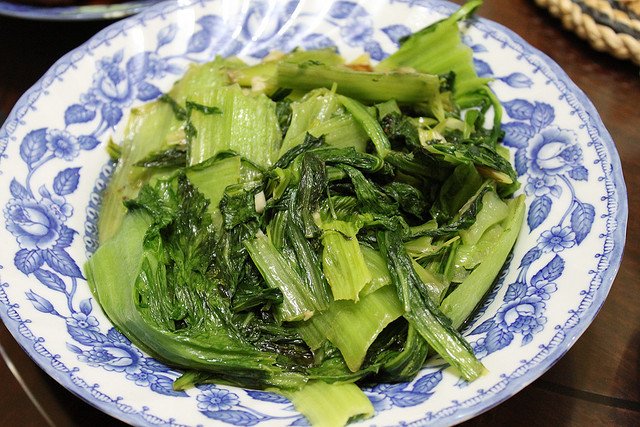
Mustard greens: changnian cai 長年菜
Mustard greens, when eaten entirely, symbolize longevity.
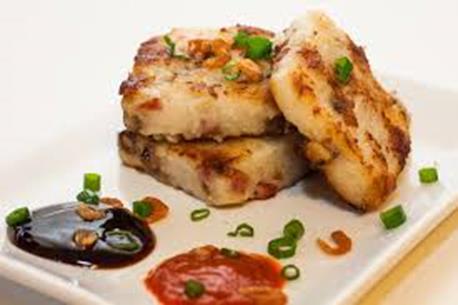
Turnip cake: luo buo gao 蘿蔔糕
Turnip cakes are associated with the phrase, "hao cai tao" 好彩頭, which translates to good luck.
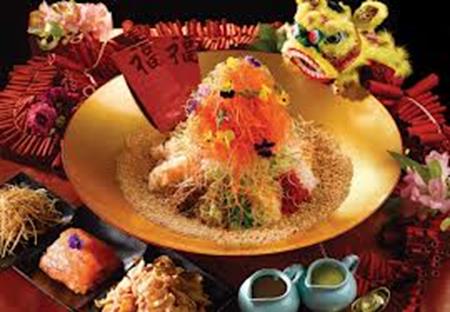
Chinese New Year Salad: Yu Sheng 鱼生
This dish is traditionally served on “everyone’s birthday” or the seventh day of Chinese New Year. The higher you toss the salad, the greater your luck and success in the New Year!
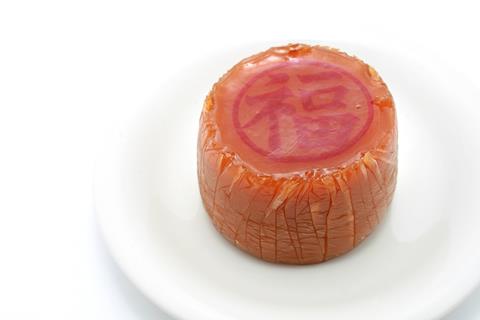
Nian Gao: Year Cake 年糕
This desert is supposed to help those eating it climb the social ladder. This is because nian gao is a homonym for “higher year.”

If books like Professor Campbell’s “China Study” are to be believed, over the past thirty years nutrition has been underfunded and overlooked by western medicine. By contrast in China the nutritional precepts of traditional medicine remain highly prevalent in contemporary life. For many generations Chinese doctors have categorized foods according to their properties in order to analyze their dynamic impact with the human body, and as a result Chinese people will commonly discuss these issues in their daily life. Over lunch with a Traditional Chinese Medical doctor, you will have the opportunity learn the tested principles of a healthy diet, including the energies of foods, the flavors and directions of foods, the key differences in Eastern and Western nutritional therapy and how to eat with the seasons.
Note: This Imperial Moment is only available now through July 2015 for visits in Beijing.
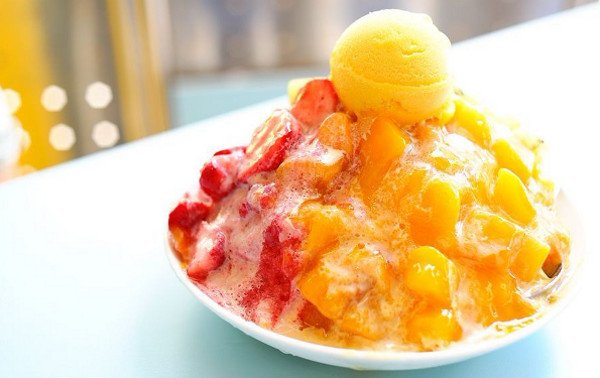
I often get asked if it’s really hard for an Italian to have to eat gluten-free (GF), and in China too. No pasta? No dumplings? What *do* you eat?? Luckily, China has always been a fairly GF-friendly country. With the rare exception of restaurants specializing in wheat-based noodles or dumplings, there are always plenty of rice-based dishes to choose from, as well as rice noodles (and other GF starch noodles like mung bean or sweet potato noodles…). Corn, millet and buckwheat are easy to find in most supermarkets. The trickiest ingredient, I find, is soy sauce, which does contain gluten and is ubiquitous in Chinese cuisine, so you need to make sure that your dish can be prepared for you without it. In big cities like Beijing or Shanghai, more and more GF food is available at stores specializing in imported goods, or from online stores; a handful of bakeries now even offer freshly baked GF bread, cookies or cake, so all in all China’s culinary landscape has been fairly easy to navigate.
Eating out can still be challenging, if you don’t speak Chinese, but high-level restaurants and hotels these days are well aware of what gluten is, where it’s found and what possible alternatives are. I am always hugely impressed when a warm GF roll is placed on the table for me, or when I am thoughtfully offered quinoa salad instead of a sandwich in a packed lunch. Not all restaurants in China, though, and not all of those involved in the preparation and delivery of your food will be so switched on, of course. The concept of food intolerances in China is still fairly new, and cultural and linguistic discrepancies often lead to confusion (which is how a vegetarian stating “I don’t eat meat” may puzzlingly be served salmon, or someone wishing to avoid pork may have to send back a dish with bacon bits on it!). But this is exactly what your guide or your China Host are there for. They are well aware of what gets lost in translation and can make sure that your dietary requirements are respected.
I also strongly encourage you to take full advantage of a cuisine that knows a thing or two about cooking with rice, especially in the south. Dim Sum, for instance, doesn’t only mean wheat-based dumplings and pastries, changfen – a type of stuffed rice noodle rolls – is a delicious GF alternative (hold the soy sauce…). Glutinous rice desserts are omnipresent (don’t be afraid, ‘glutinous’ here just means ‘sticky’) and you’ll also be surprised at how versatile tapioca is, from puddings to sago fruit drinks (fresh fruit juice with little tapioca balls in it). Taiwanese-style baobing, mounds of shaved ice covered in fresh fruit, azuki beans or peanut butter sauce, are also safe options and absolutely delicious on a hot summer day.
Valeria is a Beijing-based Senior Itinerary Designer from the Italian Alps region on the border with France. She speaks native-level French and Italian, excellent English and wonderful Mandarin Chinese. Her passion for the scenery of her homeland has led her to deepen her knowledge of China’s less traveled paths, particularly in the provinces of Sichuan and Yunnan, where she lived and studied for some time. Valeria also happens to be Imperial’s resident tea expert.